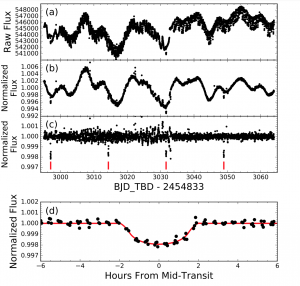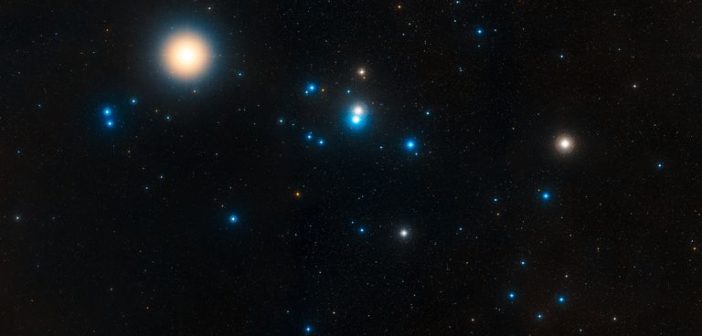Editor’s note: Astrobites is a graduate-student-run organization that digests astrophysical literature for undergraduate students. As part of the partnership between the AAS and astrobites, we repost astrobites content here at AAS Nova once a week. We hope you enjoy this post from astrobites; the original can be viewed at astrobites.org!
Title: K2-NnnA b: A Binary System In The Hyades Cluster Hosting A Neptune-Sized Planet
Authors: David R. Ciardi, Ian J. M. Crossfield, Adina D. Feinstein et al.
First Author’s Institution: Caltech/IPAC-NASA Exoplanet Science Institute
Status: Submitted to AJ, open access
The authors of today’s paper report the discovery of a Neptune-sized planet in the nearby Hyades Cluster orbiting within a binary star system. A binary consists of two stars mutually orbiting their center of gravity; the larger star is called the primary and the smaller is the secondary. In a close binary where the stars are separated only by a short distance, each of the two stars affects the evolution and size of the other.
The binary system in today’s paper is referred to as EPIC 247589423 (also called LP 358-348), but the primary and secondary stars within this system are called K2-NnnA and K2-NnnB, respectively. Since the planet discovered in this system orbits just the primary star, the authors of this paper refer to it as K2-NnnA b: exoplanets are generally named after their host star and then have another letter added to the end. However, this planet does not yet officially have a name, so there is hope that it will be called something that rolls off the tongue a bit more easily.
Significance to Planetary Formation and Evolution
Planets in binaries form under the influence of two stars — an extreme environment for planet formation, particularly if the two stars are close. The system EPIC 247589423 has a very close separation of 40 AU, which is roughly the distance from Pluto to the Sun. Using our solar system as an example, if we replaced Pluto with a star, it is easy to see that the rotation and generally everything about the planets would be drastically affected.
Studying binary-orbiting planets like K2-NnnA b allows us to test the robustness of planet formation, since the planets have to survive in an extreme environment for a long time. These systems also let us test how often planets are retained by their host star rather than being destroyed by the changing gravitational field. What’s more, by finding and studying planets in star clusters, we may begin to understand how planetary systems form and evolve and find out the timescale for such events.
K2 and Follow-up Observations
K2, or as I like to call it, Zombie Kepler, is the current mission for the Kepler Space Telescope. The Kepler Space Telescope was launched in 2009 with the mission of finding exoplanets through transit photometry. The method of transit photometry means recording the brightness of the star for an extended period of time, then looking for any small periodic ‘dips’ in the brightness that occur when an exoplanet eclipses a small part of the star. This data is generally referred to as a light curve, since there is a rounded dip where the exoplanet eclipses the star. After a mechanical mishap in 2013 with the Kepler Space Telescope, the scientists working on this mission still found a way to use the telescope to look for transiting exoplanets. Instead of observing one single part of the sky for an extended period of time as before, K2 now observes smaller patches of the sky for shorter amounts of time. Figure 1 shows several stages of the light curve analysis from K2.

Figure 1: This shows the light curve of EPIC 247589423 in various stages of analysis from K2. The topmost panel shows the light curve with the telescope rotation removed. The second panel shows the binned version of the top panel. The third shows the data with the stellar variability removed, and the lowest panel shows the folded and binned result for the planet transit. [Ciardi et al. 2017]
After the initial discovery with K2, the researchers followed up their detection with new observations and archival data to confirm the planet’s presence. They used the archival data from 1950 Palomar Observatory Sky Survey to rule out any other object that could be causing the dip in the light curve — for example, another eclipsing binary behind the system, which could create variation in the light curve that could be mistaken for a planet — and then made additional observations of the system using the Keck I telescope.
K2-nnnA b: Planet Properties
The EPIC 247589423 binary system is located in the nearby Hyades cluster — a cluster roughly 750 Myr old and the nearest star cluster to the Sun. The two stars are separated by about 40 AU. The planet orbits the star K2-NnnA with a period of 17.3 days, and its transit lasts roughly 3 hours.
K2-NnnA b is one of the first Neptune-sized planets that has been observed orbiting in a binary system within an open cluster. The discovery of this planet can provide us with a better understanding of the planet population in stellar clusters and allow us to place more limits on planetary formation and evolution.
The authors of this paper say planets discovered in nearby star clusters ‘provide snapshots in time and represent the first steps in mapping out [planetary]evolution,’ and I wholeheartedly agree. The discovery of K2-NnnA b brings with it new understanding of planet formation in star clusters and in binary systems. The possibilities of planet formation and evolution are certainly not limitless, and with more and more discoveries like K2-NnnA b, we can hopefully find the extremes of planetary systems.
About the author, Mara Zimmerman:
Mara is working on her PhD in astronomy at the University of Wyoming. She has done research with Heartbeat binary stars and currently works on modeling debris disks.

2 Comments
Pingback: A Neptune in the Nearby Hyades – MeasurementDataBases for Industry & Science
Pingback: More Planets in the Hyades Cluster